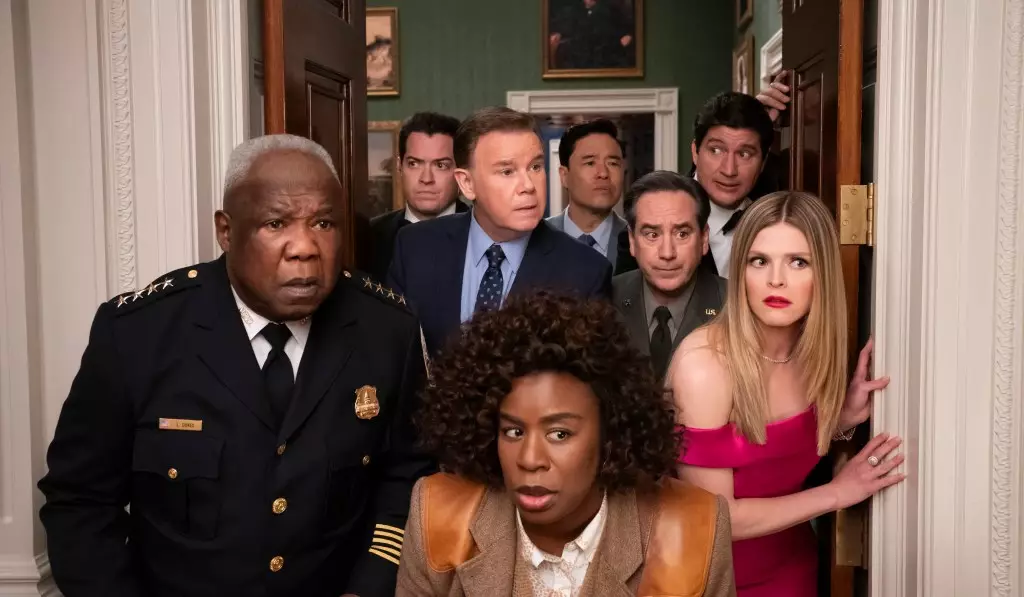In the bustling realm of Netflix’s offerings, “The Residence” stands out as a delightful blend of humor and suspense, immersing viewers in a murder mystery that unfolds within the prestigious walls of the White House. Far from just a typical crime drama, this series weaves comedic elements through an intricate tapestry of characters, each suspecting the other while harboring their own secrets. At its core, it is the seemingly simple yet elaborate plot of “132 rooms, 157 suspects, one dead body, and a disastrous State Dinner” that captures our attention, yet it is the nuanced performances that truly elevate this show.
The central twist revolves around the murder of Chief Usher A.B. Wynter, played by the vastly talented Giancarlo Esposito. Wynter, projecting authority and decorum, is an irreplaceable part of the White House hierarchy—but without proper foresight, his demise introduces both chaos and dark comic relief into the political sphere. Staging a murder amidst the opulence of a state dinner puts forth a thought: what lies behind the polished surfaces of power? The show’s clever play on traditional murder mystery tropes keeps audiences guessing, but it fundamentally invites a deeper exploration of human nature and ambition.
Character Complexity: The Usher and His Circle
The brilliance of “The Residence” does not solely lie in its plot twists, but in how it crafts its characters. With figures like Lily Schumacher—a social secretary whose cheerful exterior masks deeper ambition—the show critiques the very fabric of political interactions while simultaneously advancing its gripping narrative. Played with finesse by Molly Griggs, Lilly is thick with personality, reminiscent of a lively but dangerous socialite who changes the game by virtue of cunning and chance.
While viewers are introduced to a dozen or so suspects from different strata of the White House social pyramid—including the chef, the engineer, and even foreign diplomats—each character is painted with shades of intrigue and questionable motives. They are not merely a list of suspects; they encapsulate the anxieties and desires of those aiming for power. Their interactions are fraught with tension and veiled threats, compelling the narrative to a feigned sense of innocence before revealing underlying duplicity.
A Surprising Reveal That Leaves Us Awestruck
One of the most refreshingly unexpected aspects of the season finale was the revelation of the killer: Lilly Schumacher. Throughout the season, many viewers held preconceived suspicions toward various characters, and yet the structure of the series expertly masked Lilly’s true intentions. Paul William Davies, the creator, approached the finale with a keen awareness of audience expectations, incorporating elements that kept viewers guessing. His assertion that the ending should feel satisfying, both surprising and plausible, reflects a keen understanding of narrative mechanics.
Behind the scenes, actors like Uzo Aduba and Randall Park expressed their genuine astonishment at who ultimately turned out to be the murderer. Their reactions exemplify a community of collaborators that remains interconnected even as they portray markedly dissimilar roles. The revelation underscores the power of a solid ensemble cast, where everyone contributes to a larger mystery, fostering a collective narrative depth.
The Churning Waters of Suspicion and Friendship
Perhaps the most alluring component of “The Residence” rests in its representation of relationships amongst the suspects. With simmering tensions and undercurrents of rivalry, the dynamics between characters such as A.B.’s deputy Jasmine Haney and the President’s chief advisor Harry Hollinger create fertile ground for speculation. Their subtle interactions, imbued with complexity, point toward potential alliances or betrayals, indicating that in a game rife with power struggles, trust is a delicate and often ephemeral commodity.
The tantalizing suggestion of possible collaboration between Jasmine and Harry reinforces the intrigue and nourishes the audience’s appetite for conspiracy. Such moments hint at deeper narratives lurking beneath the surface, revealing characters that could easily swap roles between friends and foes.
Ultimately, “The Residence” serves an exhilarating buffet of comedy, drama, and intrigue—capturing the ambiguous essence of humanity within a singular murderous event. The series not only entertains with its charm and wit but also compels viewers to reflect on the bizarre contradictions of the political world, where both humor and horror often reside in the same room.

Leave a Reply